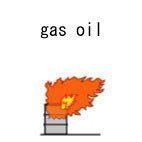| Case Name |
Fire of gas oil caused due to leakage from a bonnet flange of a valve usually not used at an atmospheric distillation unit |
| Pictograph |

|
| Date |
January 21, 1990 |
| Place |
Sakai, Osaka, Japan |
| Location |
Refinery |
| Overview |
A fire broke out around a high-temperature pump in the ADU under normal operation. A defective gasket of the bonnet flange of the laid-down valve caused leakage. The leaked gas oil made contact with a high-temperature area and ignited. As a small leakage is difficult to detect, equipment has to be arranged taking the possibility of fire from leakage into account, and regular patrols are also required. |
| Incident |
At an atmospheric distillation unit (ADU) during operation, leakage from a valve of piping that was normally not in use caused a fire. Gas oil leaked from a bonnet flange of a laid-down valve in gas oil piping used for cleaning, and a fire occurred around an adjacent pump (oil temperature 300 °C).
A laid-down valve; the valve used for construction and not in use now. |
| Processing |
Manufacture |
| Individual Process |
Distillation |
| Substance |
Gas oil |
| Type of Accident |
Leakage, fire |
| Sequence |
13:19. On January 21st, 1990. An operator on patrol found a fire.
13:20. The ADU was stopped emergently.
13:37. Public fire engines arrived at the site.
14:45. The fire was extinguished. |
| Cause |
Gas oil leaked due to rupture of a gasket of a valve bonnet flange. It caused a fire either by contacting high-temperature areas or entering heat insulation. The cause of the gasket rupture is not clear. Partial defects in production, tightening errors on mounting of the valve, or degradation during use are possible causes. |
| Response |
Extinguished by water |
| Countermeasures |
1. Unnecessary valves were changed to short piping.
2. Flanges, which were mounted above the high temperature equipment, were re-tightened and the leakage was checked.
3. Flanges and valves should not be mounted above high-temperature equipment. |
| Knowledge Comment |
In facilities handling flammables, small leakage can cause a major fire. |
| Background |
Because the location of the leakage valve was in the upper part of a high-temperature pump, leaked oil touched the pump and caused the fire. The location of the valve was considered to be improper. It might not be a design defect, but there can be said to have been insufficient consideration.
Although it is not clear how the laid-down valve was managed, a proper inspection might have been neglected including an airtight test, because it did not have any operational functions. In particular, the bonnet flange tends to attract little attention. |
| Incidental Discussion |
Laid-down valves are necessary only for construction work. They increase the possibility of leakage. The number of them should be minimized. |
| Reason for Adding to DB |
Example of fire caused due to breakage from material degradation or mounting errors |
| Scenario |
| Primary Scenario
|
Poor Value Perception, Poor Safety Awareness, Insufficient Safety Measure, Insufficient Analysis or Research, Insufficient Practice, Lack of Imagination, Planning and Design, Poor Planning, Poor Piping Design, Usage, Maintenance/Repair, Wrong Gasket Monuting, Malfunction, Poor Hardware, Gasket Leak, Secondary Damage, External Damage, Fire, Loss to Organization, Economic Loss, Manetary Damage 25 million yen
|
|
| Sources |
Fire and Disaster Management Agency. Leakage and fire of gas oil from gas oil piping for cleaning in an atmospheric distillation unit. Accident cases of dangerous materials. 1990. pp.96-97.
Sakai City and Takaishi City The Fire-Defense Headquarters. Yoshihiro Hirata. Leakage and fire accident due to the gasket rupture. Seminar on Dangerous material accidents. pp.34-38(1993).
High Pressure Gas Safety Inst. of Japan. Atmospheric distillation unit. Leakage and fire from overhead piping in Atmospheric distillation unit. Accident examples of Petroleum refinery and Petrochemical units, pp.27-29(1995)
|
| Physical Damage |
Cables, field panels of meters, a fin-fan cooler, a cradle, valves, heat insulation of the plant were damaged by heat and fire. |
| Financial Cost |
¥ 25 million (Fire and Disaster Management Agency) |
| Multimedia Files |
Fig2.Sketch of the accident flange
|
| Field |
Chemicals and Plants
|
| Author |
WAKAKURA, Masahide (Kanagawa Industrial Technology Research Institute)
TAMURA, Masamitsu (Center for Risk Management and Safety Sciences, Yokohama National University)
|